Last Updated on July 29, 2023
As a keyboard enthusiast, you know that the right lubrication can make all the difference in how your keyboard feels and sounds. Whether you’re looking for a smoother typing experience, reduced wobble, or a quieter keyboard, finding the best lube for switches and stabilizers is key.
We’ve done extensive testing and research to determine the top lubes on the market for switches and stabilizers. In this article, we’ll share our findings and recommendations with you.
What Are Switches and Stabilizers on Mechanical Keyboard?
Switches and stabilizers are two important components of a mechanical keyboard.
Switches are the individual buttons that you press when typing on a keyboard. Mechanical switches are different from the rubber dome switches commonly found on cheaper keyboards, in that they use a mechanical mechanism to register a keystroke. Mechanical switches typically provide better tactile feedback and more consistent actuation force, making them popular among gamers, programmers, and other heavy keyboard users. There are many different types of mechanical switches available, each with their own unique characteristics such as actuation force, tactile feedback, and noise level.
Stabilizers are components that help to stabilize larger keys, such as the spacebar and the shift keys. Without stabilizers, these larger keys may wobble or rattle when pressed, which can be both annoying and detrimental to typing accuracy. Stabilizers typically consist of a metal wire or plastic bar that runs beneath the keycap, along with small plastic components that help to keep the keycap level and centered when pressed. There are several different types of stabilizers available, including plate-mounted stabilizers and PCB-mounted stabilizers.
Why Lube Is Important for Smooth Mechanical Keyboard Operation?
Lubrication, or “lube” for short, is important for smooth mechanical keyboard operation because it helps reduce friction and wear between the various moving parts within the switches.
Mechanical keyboards consist of individual switches that contain a stem that moves up and down when a key is pressed. This stem rubs against other parts of the switch, including the housing and the metal contacts that register the keystroke. Over time, this repeated motion can create friction and wear on these components, which can lead to a rough, scratchy feeling when typing and may even cause the switch to fail prematurely.
By applying a thin layer of lubricant to these moving parts, you can reduce the amount of friction and wear that occurs during use. This can help make the keyboard feel smoother and more consistent over time, as well as help extend the lifespan of the switches.
It’s worth noting that not all switches require lubrication, and that over-lubrication can actually cause problems with switch operation. Therefore, it’s important to research and follow proper lubrication techniques for your specific keyboard and switches.
Different Types of Lube Available for Switches and Stabilizers
When it comes to mechanical keyboard switches and stabilizers, there are several types of lubricants that can be used to improve their performance and reduce noise. Here are some of the most common types of lubes used in keyboard modding:
- Thin Lubricant: This type of lube is used for switches and stabilizers where a very thin layer of lubrication is desired. Thin lubricants are generally used on linear switches or for the inside of stabilizer housings to reduce friction and improve smoothness.
- Thick Lubricant: This type of lube is used for switches and stabilizers where a thicker layer of lubrication is desired. Thick lubricants are generally used on tactile switches or for the outside of stabilizer housings to reduce rattling.
- Grease Lubricant: This type of lube is a thicker, heavy-duty lubricant that is used for stabilizers or switches that require a lot of lubrication to reduce friction and noise. It is usually used on the metal wire of stabilizers and is applied with a brush.
- Oil Lubricant: This type of lube is used for switches and stabilizers where a very light layer of lubrication is desired. It is often used on linear switches or for stabilizers to reduce friction and noise.
It’s important to note that different lubes can have different effects on the feel and sound of your keyboard, and choosing the right lube for your switches and stabilizers can take some experimentation. Additionally, it’s important to use lubes that are safe for use with plastics and metals commonly found in keyboards, as some lubes can cause damage over time.
Factors to Consider When Choosing Lube
When choosing a lubricant for switches and stabilizers, there are several factors to consider:
- Viscosity: The viscosity of the lubricant will affect how well it will stay in place and how smoothly it will flow over the surfaces. Thicker lubricants may provide better protection and last longer, but may also affect the feel of the switches and stabilizers.
- Compatibility: Not all lubricants are compatible with all materials. Make sure the lubricant you choose is compatible with the plastics and metals used in your switches and stabilizers to avoid damage or degradation.
- Application method: Some lubricants are easier to apply than others, and some may require special tools or techniques. Consider the application method and your own experience with lubrication before choosing a lubricant.
- Longevity: How long the lubricant will last before needing to be reapplied can also be a factor. Some lubricants may need to be reapplied more frequently than others.
- Feel: The feel of the switches and stabilizers can be affected by the choice of lubricant. Some lubricants may make switches and stabilizers feel smoother or more tactile, while others may make them feel more sluggish.
- Personal preference: Ultimately, the choice of lubricant may come down to personal preference. Some people prefer a certain feel or sound from their switches and stabilizers, and may choose a lubricant that provides that specific effect.
The Best Lube for Switches and Stabilizers: Our Top Picks
| Linear Switches | Tactile Switches | Clicky Switches | Stabilizers |
| G-Lube Glorious | G-Lube Glorious | G-Lube Glorious | G-Lube Glorious |
| Krytox 205g0 | Krytox 205g0 | Krytox GPL 105 | Permatex 22058 Dielectric Tune-Up Grease |
| Tribosys 3203 | Tribosys 3203 | ||
| Trbisosy 3204 | Trbisosy 3204 | ||
| Krytox 105 Oil | Krytox 105 Oil |
In the tables above, it is the best choice for lubricating switches and mechanical keyboard stabilizers. For switches, you need a different type of lubricant for each type of switch. For linear switches we recommend using G-Lube Glorious or Krytox 205g0 lubricant, for tactile switches we recommend G-Lube Glorious or Krytox 205g0 (avoid the legs), and for clicky switches we recommend G-Lube Glorious or Krytox GPL 105 (spring only).
As for stabilizers, we recommend Preferred: G-Lube Glorious or Krytox 205g0 and Dielectric Grease by Permatex, these are the products that are most often offered when you want to buy a stabilizer in mechanical keyboard stores. For another alternative, you can use any other dielectric grease as a lubricant for your stabilizer.
G-Lube Glorious

| Component | Description |
|---|---|
| Base Oil | Synthetic oil with low viscosity and high lubricity |
| Additives | Anti-wear, anti-oxidation, and anti-corrosion additives |
| Thickener | Polyurea thickener to enhance the oil’s viscosity and improve its retention on surfaces |
| Dropper Bottle | Convenient dropper bottle for easy and precise application |
G-Lube Glorious has a smooth and consistent texture that makes it easy to apply to switches and stabilizers. The lube is not too thick or too thin, making it easy to spread evenly over the components.
One of the standout features of G-Lube Glorious is its performance. The lube is effective at reducing the noise and friction of switches and stabilizers. It also helps to improve the overall smoothness and feel of the keyboard, making typing more enjoyable.
G-Lube Glorious is compatible with a wide range of mechanical keyboard switches and stabilizers. This means that you can use it with most mechanical keyboards, regardless of the brand or model.
Another advantage of G-Lube Glorious is its longevity. The lube does not dry out or wear off easily, which means that you won’t need to reapply it frequently. This makes it a great option for people who want a long-lasting lube that requires minimal maintenance.
Applying G-Lube Glorious is relatively easy, and you don’t need any special tools or skills to do it. The lube comes with an applicator brush, which makes it easy to apply the lube precisely where you need it. This helps to reduce the risk of over-lubricating or under-lubricating your switches or stabilizers.
Overall, G-Lube Glorious is an excellent choice for anyone who wants to improve the performance and feel of their mechanical keyboard. Its smooth texture, compatibility with different switches and stabilizers, long-lasting performance, and easy application make it one of the best lubes for switches and stabilizers on the market.
Krytox 205g0

| Component | Chemical Name | Function |
|---|---|---|
| Fluorinated Oil | Perfluoropolyether oil (PFPE) | Main lubricating component that reduces friction and wear. |
| Thickener | Polytetrafluoroethylene (PTFE) | Provides viscosity and prevents the lubricant from leaking or migrating. |
| Additives | None specified | May include antioxidants, corrosion inhibitors, or other additives to enhance the lubricant’s performance. The exact composition of the additives is not disclosed by the manufacturer. |
Krytox 205g0 is a thick lubricant with a viscosity of approximately 800,000 cSt (centistokes). This thickness helps to reduce friction between switch components and dampen any rattling or wobbling, resulting in a smoother typing experience. The texture of Krytox 205g0 is smooth and easy to apply, making it ideal for lubing switches.
Krytox 205g0 provides excellent results for both linear and tactile switches, making it one of the most versatile switch lubes on the market. For linear switches, Krytox 205g0 helps to reduce friction between the stem and housing, resulting in a smoother and quieter typing experience. For tactile switches, Krytox 205g0 helps to reduce the sound of the tactile bump, making it less pronounced and smoother.
Krytox 205g0 is a long-lasting lubricant and can provide smooth switch performance for up to a year or more. The longevity of Krytox 205g0 can be attributed to its high viscosity, which helps to prevent the lubricant from evaporating or wearing out quickly.
Krytox 205g0 is easy to apply to switches using a brush or syringe. It is important to apply a small amount of lube to each switch to avoid over-lubrication, which can lead to a gummy or sluggish feel. It is also important to ensure that the lube is evenly distributed across the switch components for optimal performance.
Overall, Krytox 205g0 is an excellent switch lubricant for both linear and tactile switches. Its high viscosity and smooth texture provide excellent performance and longevity, while its easy application makes it ideal for keyboard enthusiasts of all skill levels. If you are looking to improve the smoothness and sound of your switches, Krytox 205g0 is definitely worth considering.
Tribosys 3203
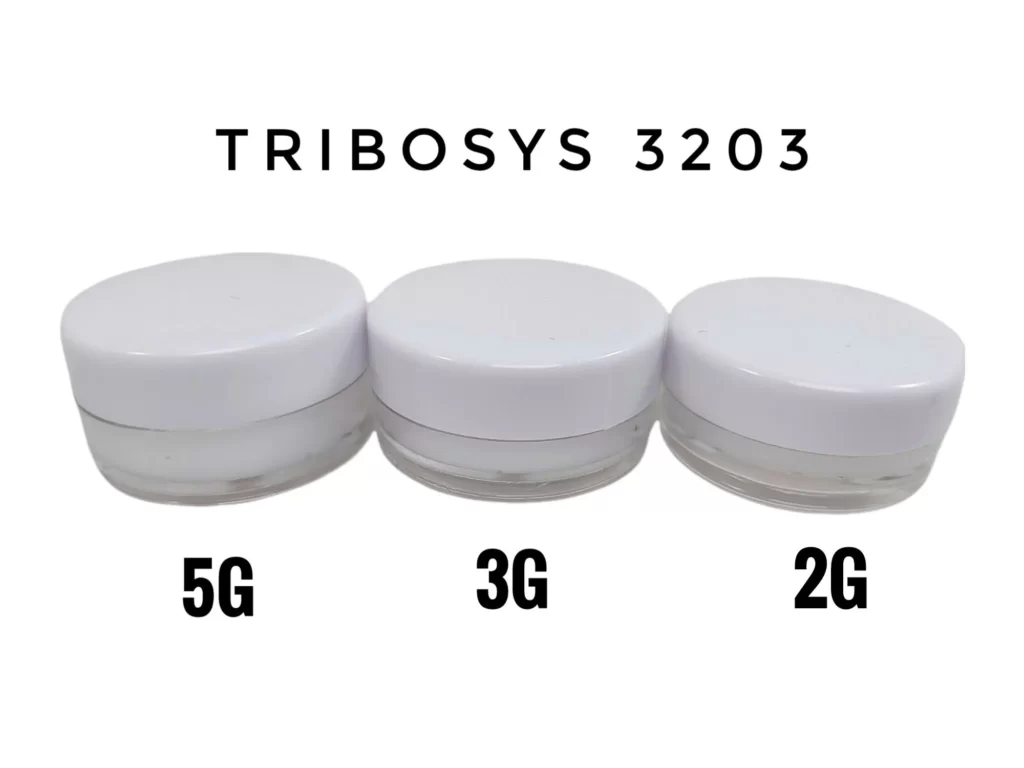
| Component | Description |
|---|---|
| Polyalphaolefin (PAO) oil | A synthetic oil with excellent lubricating properties and good chemical stability. It is widely used in industrial and automotive applications. |
| Calcium complex thickener | A type of grease thickener that provides excellent mechanical stability, high dropping point, and good resistance to water and oxidation. |
| Zinc dialkyldithiophosphate (ZDDP) | An anti-wear additive that forms a protective film on metal surfaces, reducing wear and extending the life of the lubricated components. |
| Toluene | A solvent used to dissolve the thickener and the additives and to adjust the viscosity of the final product. |
| Ethyl alcohol | A solvent used to dissolve the thickener and the additives and to adjust the viscosity of the final product. |
| Ethyl benzene | A solvent used to dissolve the thickener and the additives and to adjust the viscosity of the final product. |
| Molybdenum disulfide (MoS2) | A solid lubricant that provides excellent wear protection and reduces friction. It is commonly used in high-pressure and high-temperature applications. |
| Graphite | A solid lubricant that provides excellent wear protection and reduces friction. It is commonly used in high-temperature applications. |
Tribosys 3203 has excellent lubrication performance, which makes it ideal for use in switches. It provides a smooth, silky feel to the switches, making them feel buttery and tactile. It also helps to reduce friction, which can lead to smoother switch operation and less wear and tear on the switches.
Tribosys 3203 is easy to apply and can be used in a variety of ways. It can be applied directly to the switch stem or housing using a brush or applicator, or it can be applied using a syringe for more precise application. The consistency of the lubricant is ideal for switches and it spreads easily and evenly.
Tribosys 3203 is a long-lasting lubricant that provides excellent performance over time. It does not dry out or degrade, which means that it can be used for extended periods without the need for reapplication. This makes it a cost-effective option for those who want to maintain the performance of their switches over time.
Tribosys 3203 is compatible with a wide range of switch types, including linear and tactile switches. It can be used with both plastic and metal housings, and it is safe for use with PCBs and other electronics.
Tribosys 3203 is priced reasonably and offers excellent value for money. A small amount of the lubricant can go a long way, which means that a single container can last for a long time.
In conclusion, Tribosys 3203 is an excellent lubricant for linear and tactile switches. It provides excellent lubrication performance, is easy to apply, long-lasting, compatible with a wide range of switch types, and reasonably priced. It is no surprise that it is widely considered one of the best options for switch lubrication among enthusiasts and professionals alike.
Trbisosy 3204

| Component | Property |
|---|---|
| Polydimethylsiloxane | Lubricating oil with high viscosity and temperature stability |
| Lithium Stearate | Thickening agent and anti-wear additive |
| Zinc Stearate | Anti-wear additive |
| Calcium Stearate | Anti-wear additive |
| Ethylene Propylene Diene Monomer | High-temperature resistant polymer used to improve the stability of the lubricant |
Trbisosy 3204 is a popular lubricant in the mechanical keyboard community, known for its excellent performance in reducing friction and improving the smoothness of linear and tactile switches. It is a high-viscosity lubricant, which means that it is thick and sticky and provides long-lasting lubrication.
One of the main benefits of using Trbisosy 3204 is that it helps to reduce the scratchiness and wobble that can occur in switches over time. This makes the switches feel smoother and more responsive, which can enhance the typing or gaming experience. The lubricant is also known for its consistency, which makes it easy to apply and distribute evenly on the switch housing.
Another advantage of Trbisosy 3204 is that it does not attract dust and dirt, which can accumulate over time and affect the switch’s performance. It is also non-conductive, which means that it will not damage the switch or interfere with its electrical conductivity.
However, it is important to note that the performance of Trbisosy 3204 can vary depending on the specific type of switch being used. For example, some users report that it works better for linear switches than for tactile switches. Additionally, the viscosity of the lubricant may be too high for some users, resulting in a thicker and more sluggish feel.
Overall, Trbisosy 3204 is considered one of the best lubricants for linear and tactile switches by many enthusiasts and professionals in the mechanical keyboard community. Its excellent performance in reducing friction, improving smoothness, and preventing dirt accumulation makes it a popular choice for those looking to enhance their keyboard’s performance.
Krytox 105 Oil
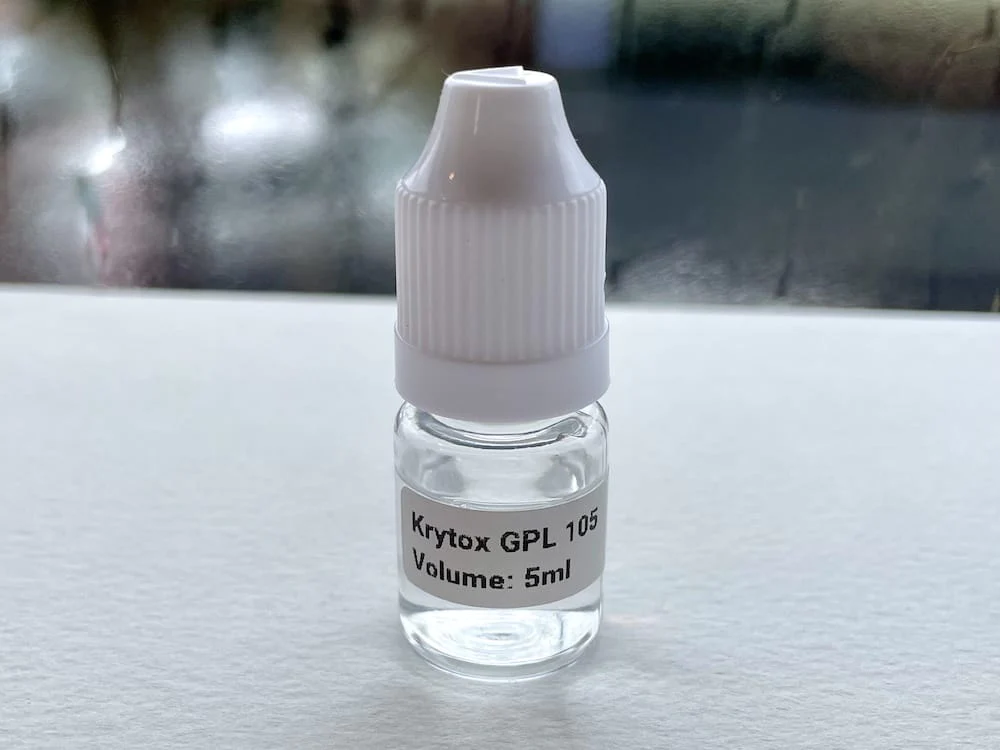
| Component | Chemical Formula | Percentage by Weight |
|---|---|---|
| Perfluoropolyether Oil | N/A | 100% |
| Polyhexafluoropropylene Oxide | C3F6O | <0.01% |
| Perfluoroalkoxy Alkanes | N/A | <0.01% |
| Fluorinated Ethers | N/A | <0.01% |
| Tetrafluoroethylene Oligomers | (C2F4)n | <0.01% |
Krytox 105 oil is a high-performance lubricant that is considered one of the best lubes for both linear and tactile switches in the mechanical keyboard community.
Firstly, Krytox 105 oil is a synthetic, fluorinated lubricant that has excellent thermal stability, chemical resistance, and low vapor pressure. These properties make it ideal for use in harsh environments and high-temperature applications, such as mechanical keyboard switches. Additionally, Krytox 105 oil is non-toxic and non-flammable, making it safe to use and handle.
When it comes to switch lubing, Krytox 105 oil is known for providing a smooth, buttery feel to switches that can enhance the overall typing experience. It can reduce or eliminate scratchiness, wobble, and friction in switches, leading to a quieter, smoother typing experience. In tactile switches, Krytox 105 oil can improve tactility, making the switch feel crisper and more defined.
Krytox 105 oil can be used on a wide range of switches, including linear and tactile switches. It is particularly effective on linear switches, such as Cherry MX Blacks, where it can provide a noticeable improvement in smoothness and reduce noise. For tactile switches, such as Zealios or Holy Pandas, Krytox 105 oil can make the bump more pronounced and satisfying.
When it comes to application, Krytox 105 oil is best applied using a brush or syringe. A small amount of the lubricant should be applied to the contact points of the switch, such as the stem, housing, and spring. It is essential not to over-apply the lubricant, as this can lead to mushiness and reduce switch responsiveness.
Overall, Krytox 105 oil is an excellent choice for switch lubing. Its thermal stability, chemical resistance, and low vapor pressure make it a safe and effective lubricant for mechanical keyboard switches. It provides a noticeable improvement in switch smoothness, reduces noise, and can enhance tactility in tactile switches. If you are looking for a reliable and high-quality switch lubricant, Krytox 105 oil is definitely worth considering.
Krytox GPL 105

| Component | Description |
|---|---|
| Base Oil | The main component of Krytox GPL 105 is a perfluoropolyether (PFPE) base oil. PFPEs are highly stable and provide excellent lubrication properties, even at high temperatures and in harsh environments. They are also resistant to oxidation, corrosion, and chemical attack. |
| Thickener | Krytox GPL 105 contains a polytetrafluoroethylene (PTFE) thickener, which helps to provide additional film strength and wear protection. PTFE is a non-reactive material that can withstand extreme temperatures and pressures. |
| Additives | Krytox GPL 105 may also contain various additives, such as rust inhibitors, anti-wear agents, and extreme pressure (EP) additives. These additives help to further enhance the lubrication properties of the grease and improve its performance in specific applications. |
| Solvents | Krytox GPL 105 may be formulated with solvents to aid in its application or to modify its consistency. Solvents can help to reduce the viscosity of the grease and make it easier to apply or to thicken the grease for more demanding applications. |
Krytox GPL 105 is a high-performance lubricant that is considered by many to be one of the best lubricants for clicky switches. This lubricant is made by Chemours and is a type of fluorinated oil that is specifically designed for use in mechanical keyboards.
One of the main benefits of Krytox GPL 105 is its excellent lubricating properties. It is a very effective lubricant that provides long-lasting protection for your switches. This lubricant is also very resistant to degradation and can withstand high temperatures without breaking down. This means that it will continue to provide smooth and consistent operation even under heavy use.
In addition to its excellent lubricating properties, Krytox GPL 105 is also very easy to apply. It comes in a syringe applicator that allows you to apply the lubricant precisely and evenly to each switch. This makes it very easy to apply the lubricant without making a mess or wasting any of the product.
Another benefit of Krytox GPL 105 is that it is very compatible with a wide range of switch types. It is particularly well-suited for use with clicky switches, such as Cherry MX Blue or Kailh Box White switches. The lubricant helps to reduce the amount of friction and wear on the switch components, which can help to improve their lifespan and overall performance.
Overall, Krytox GPL 105 is a high-quality lubricant that is well-suited for use with clicky switches. It is very effective at reducing friction and wear on the switch components, and it is very easy to apply. If you are looking for a high-quality lubricant for your mechanical keyboard, Krytox GPL 105 is definitely worth considering.
Permatex 22058 Dielectric Tune-Up Grease
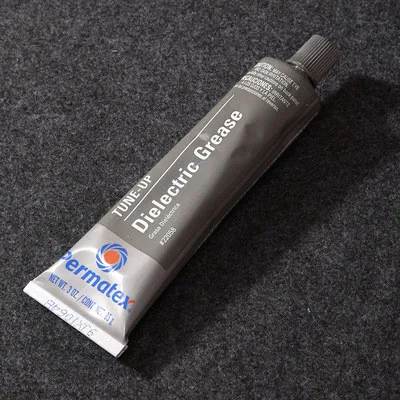
| Component | Function |
|---|---|
| Silicone oil | Lubricates and protects electrical connections from moisture and corrosion |
| Diatomaceous earth | Thickening agent to improve consistency and adhesion of the grease |
| Zinc oxide | Provides additional protection against corrosion |
| Carbon black | Improves conductivity of the grease |
| Calcium stearate | Acts as a stabilizer to maintain consistency of the grease over time |
| Mineral oil | Acts as a carrier for the other components and aids in application |
| Petroleum distillate | Solvent used to dissolve and blend the other components together |
| Proprietary additives | Improve the performance and properties of the grease, but the specific additives are not disclosed by the manufacturer |
Permatex 22058 Dielectric Tune-Up Grease is a silicone-based lubricant that is commonly used as a dielectric grease in automotive applications. However, it has gained popularity in the mechanical keyboard community as an excellent lube for stabilizers.
The first thing to note about this lube is its consistency. It is a thick, viscous grease that is easy to apply and spreads evenly. This makes it ideal for use on stabilizers, as it helps to reduce friction and smooth out the movement of the stabilizer wire.
Another advantage of Permatex 22058 is its dielectric properties. This means that it is resistant to electrical current and can prevent corrosion and electrical interference. This is important in mechanical keyboards, as the stabilizers can sometimes make contact with the circuit board, which can cause issues with electrical signals.
In addition to its lubricating and protective properties, Permatex 22058 is also long-lasting. It does not dry out or become brittle over time, which means that it will continue to provide smooth and consistent performance for a long time.
One potential downside of this lube is that it is not specifically designed for use in mechanical keyboards. This means that there is a small chance that it could damage the plastic components of the stabilizers over time. However, this risk is relatively low, and many people have used Permatex 22058 on their mechanical keyboard stabilizers without any issues.
Overall, Permatex 22058 Dielectric Tune-Up Grease is an excellent choice for anyone looking to lube their mechanical keyboard stabilizers. It is easy to apply, provides excellent lubrication and protection, and is long-lasting. While there is a small risk of damage to the plastic components of the stabilizers, this risk is relatively low and is outweighed by the benefits of using this high-quality lubricant.
How to Lube Mechanical Keyboard Switches
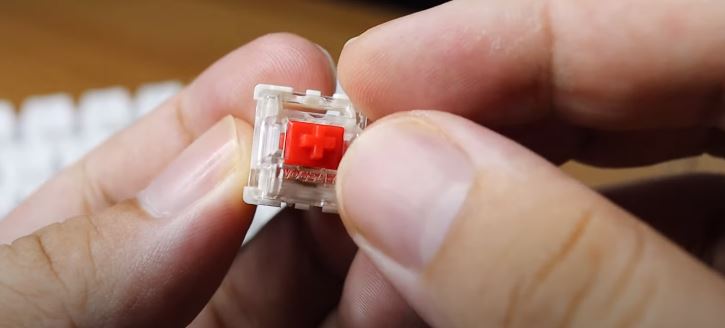
Lubricating mechanical keyboard switches can help to reduce the noise and improve the feel of the switch. It is a relatively simple process, but it does require some care and attention to ensure that the lubrication is applied correctly. Here is a step-by-step guide on how to lube mechanical keyboard switches:
- Remove the keycaps: Start by removing the keycaps from your keyboard. This will give you access to the switches underneath.
- Remove the switches: To lubricate the switches, you will need to remove them from the keyboard. You can do this by desoldering them from the PCB (printed circuit board) or using a switch puller to gently remove them from the plate.
- Clean the switches: Before applying any lubrication, it is important to clean the switches to remove any dust or debris. You can use a small brush or compressed air to clean the switches thoroughly.
- Apply the lubricant: Once the switches are clean, it’s time to apply the lubricant. You can use a thin lubricant such as Krytox or Tribosys to lubricate the contact points on the switch. Apply a small amount of lubricant to the stem, spring, and housing of the switch.
- Spread the lubricant: After applying the lubricant, use a brush or your finger to spread it evenly over the switch. You want to make sure that the lubricant is evenly distributed over all the contact points of the switch.
- Reassemble the switches: Once you have lubricated all the switches, it’s time to reassemble them. Make sure that the switches are aligned correctly and that the pins are properly inserted into the PCB.
- Test the switches: After reassembling the keyboard, test the switches to make sure that they are functioning correctly. Press each key several times to make sure that the lubrication has not affected the switch’s performance.
The tools you need to lubricate mechanical keyboard switches:
- Keycap Puller
- Switch Puller
- Small Brush
- Switch Opener
- Slider Picker
- Switch Lubricant
To lubricate your switch, you have to do a few steps first. Open the keycaps attached to the switch you want to lubricate. We will explain the next steps below.
1. Open your switch from PCB
The first thing you have to do is remove your switch from the PCB, because to lubricate the switch we can’t do it while the switch is still attached to the mechanical keyboard PCB. If you are using a hot swappable mechanical keyboard opening the switches will be very easy compared to removing the switches on a standard PCB which requires you to desolder the switches. We’ve written a tutorial if you want to learn how to Desoldering Mechanical Keyboard switches.
2. Open the switch with Switch Opener

Actually you can just open the switch using a screwdriver or other tool, but using a tool that is not recommended can damage your switch. We strongly recommend you to use the switch Opener, besides being safe to use this tool is also very easy to open the switch.
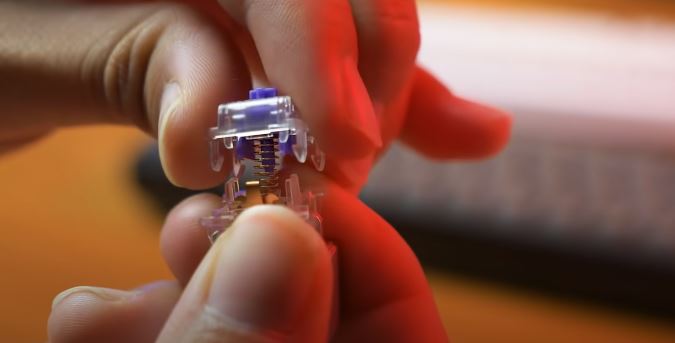
How to open a switch with a switch opener, you only need to insert the switch into the switch opener housing while pushing it, and the lever will be automatically pressed by the switch opener and will open immediately.
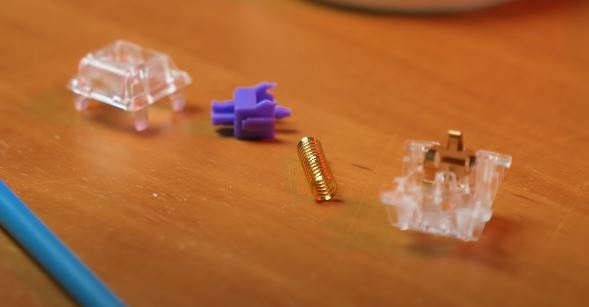
After the switch is successfully opened, separate all the components of the switch and place it on your workbench. Starting from stem switches, springs, top housing and bottom housing sepeti gambar diatas.
3. Lubricate each switch component one by one
First: lubricate the bottom housing switch.
Make sure all parts of the bottom housing switch are evenly greased.
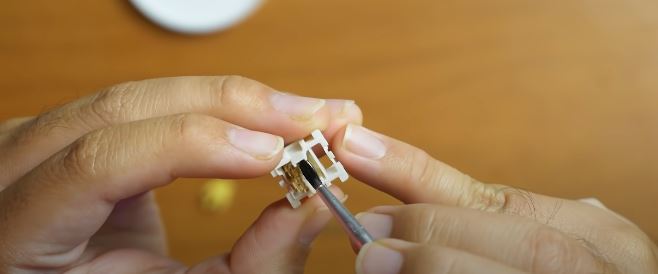
Second: lubricate the switch bearing
Lubricate the spring horizontally on each part of the spring using a small brush, making sure all parts of the spring are lubricated evenly.
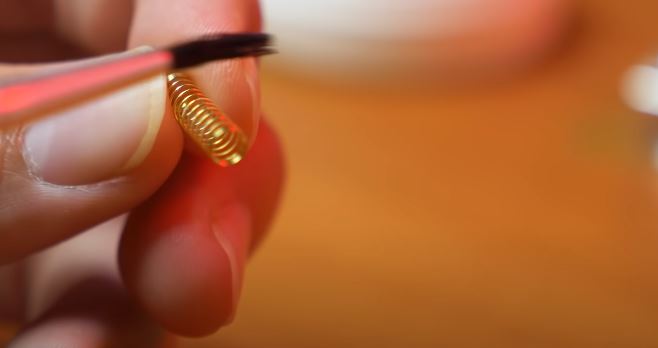
Third: Lubricate the Stem switch
On the stem switch component we use a slightly different way, this is when the slider picker works. Insert the switch head into the slider picker, this is done so that after lubricating we don’t touch the switch scheme again, because the lubricant can move from the stem switch to the hand, this will reduce the lubrication quality on the stem switch.
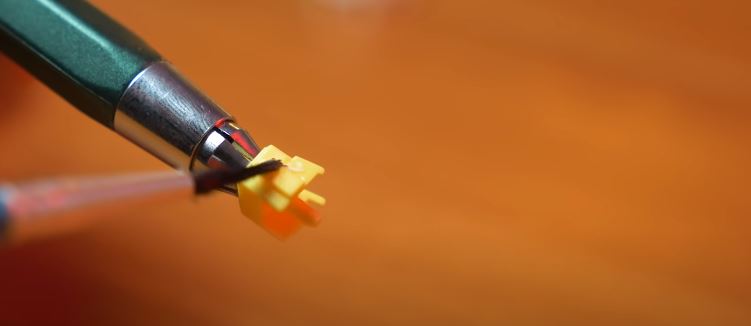
Lubricate all parts of the stem switch except the one inserted into the slider picker. After you finish lubricating the stem switch evenly, place the stem switch over the spring that has been installed on the bottom housing of the switch.

Fourth: Lubricate the top switch housing
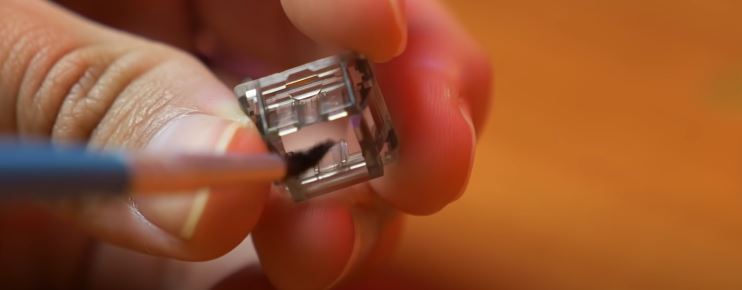
Lubricate all parts of the top housing switch that are in direct contact with the stem switch, this aims to make the stem switch movement smoother and smoother when in contact with the top housing switch.
Fifth: Replace all switch components.
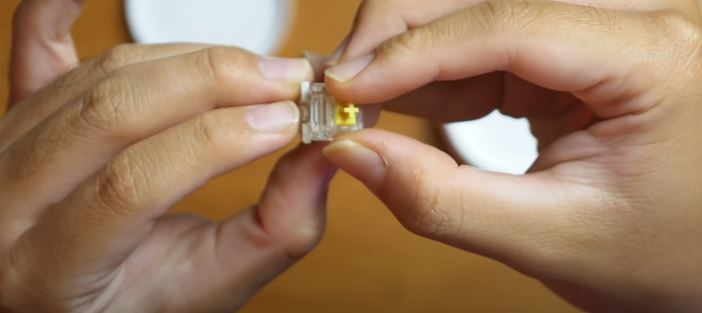
Replace all the switch components by installing the spring on the bottom housing, insert the stem switch on the top of the spring, then cover it with the top housing with a little pressure until it makes a “Tekkkk” sound. This means that the switch is back together and ready to be installed on the PCB.
Now you have finished lubricating your keyboard’s mechanical switches. Repeat the same way on each switch you want to lubricate. You have done it successfully!!
Important: There are some types of switches that cannot be easily opened to apply lubricant such as Kailh BOX Siwthes and Kailh Milk Siwtch.
Lubricating Your Switches: Linear, Tactile, and Clicky
Lubricating your favorite switch is something you can easily do after following our instructions above. But before you start lubricating your favorite switch, make sure you know the type of switch you are using.
There are 3 types of switches, namely Linear, Tactile, and Clicky. Of these three types there are different requirements when lubricating them. The most often used as a switch lubrication object is the tactile switch, because it does not require many special conditions. Then what about other types of switches? we will explain how to lubricate all three types of switches!
Lubricating The Linear Switches
Linear switches are the easiest thing to lubricate, the mechanism components inside the linear type switches are very supportive for lubrication. Linear switches are designed to provide minimum smoothness and noise when typing. If it is lubricated it will provide even greater smoothness and silence. If you have a linear switch, use the following lubricants: Krytox 205g0, Tribosys 3203, Tbisosy 3204, Krytox 105 Oil (To prevent Spring Ping). We highly recommend that you use a lubricant from Glorious, namely G-Lube Glorious, this is perfect for linear switches.
Lubricate The Tactile Switches
As I said, tactile switches are the switches that are most often used for training objects to lubricate switches, because tactile switches provide a very significant change after being lubricated, unlike linear switches which are already refined from the factory. Lubricating tactile type switches can minimize friction between components and make them smoother when moving. For lubrication recommendations, you should use G-Lube Glorious, while for other options such as Tribosys 3203, Krytox 205g0, Trbisosy 3204, and Krytox 105 Oil, it is also safe for this type of switch.
Lubricating Clicky Switches Is Quite Risky
The clicky type switch is recommended not to be lubricated, the clicky type switch is made to provide loud typing feedback with a noisy sound. If you lubricate the clicky switch, then you have changed the character to be smooth and will lose its identity as a clicky switch. Lubricate the clicky switch the same as you turn it into a smoother tactile type switch.
Overall from the choice of switch lubricants, we highly recommend G-Lube Glorious for you to use, because it is very easy to find and has quality that I think is very good for your switch. Other options such as Tribosys 3203, Krytox 205g0, Trbisosy 3204, and Krytox 105 Oil, it is also safe for Linear and tactile switches.
How to Lube Mechanical Keyboards Stabilizers
Lubricating the stabilizers on a mechanical keyboard can help reduce noise and improve the feel of the keyboard. Here are the steps to properly lubricate your stabilizers:
- Remove the keycaps: Before you can access the stabilizers, you need to remove the keycaps from the keyboard. Use a keycap puller to remove them gently.
- Identify the stabilizers: Stabilizers are located under larger keys like the spacebar, shift, and enter key. They have a metal wire that connects the keycap to the stabilizer housing.
- Remove the stabilizers: Use a pair of tweezers or pliers to remove the stabilizers from the keyboard. Gently pull the stabilizer wire out of the housing and set it aside.
- Clean the stabilizers: Use a small brush or a clean cloth to remove any dust or debris from the stabilizer housing. Be sure to clean the metal wire as well.
- Apply lubricant: Apply a small amount of stabilizer lubricant to the inside of the housing where the wire goes. You can use a brush or a toothpick to apply the lubricant. Be sure not to use too much, as this can cause the stabilizer to become mushy.
- Reassemble the stabilizer: Once you have applied the lubricant, reassemble the stabilizer by inserting the wire back into the housing. Make sure the wire is properly seated and the stabilizer housing is securely attached to the keyboard.
- Repeat for all stabilizers: Repeat the process for all stabilizers on the keyboard.
- Test the keyboard: Once you have lubricated all the stabilizers, test the keyboard to see if there is any improvement in feel and sound. If not, you may need to reapply the lubricant or try a different type of lubricant.
- Reinstall keycaps: Finally, reinstall the keycaps on the keyboard. Be sure to press them firmly to ensure they are properly seated.
Note: It’s important to use a lubricant specifically designed for stabilizers as other types of lubricants may damage the plastic or rubber parts of the stabilizers. Also, make sure to use a small amount of lubricant and avoid over-lubricating the stabilizers as this can lead to a mushy feel and reduced performance.
Lubricating the stabilizer is very easy, you only need to open the keycaps which have stabilizers usually attached to the spacebar, left and right shift, enter, and backspace keys. After opening it, you can read this article to how to lubricate the mechanical stabilizer of your keyboard using a toothpick.
The Guide is Here: How to Lube Switches without Desoldering – Here is The Complete Guide
Conclusion
In conclusion, choosing the right lubricant for your mechanical keyboard switches and stabilizers is crucial to improve their performance and lifespan. After considering the various options available in the market, G-Lube Glorious stands out as the best all-purpose lubricant that is suitable for both switches and stabilizers.
For those who prefer specific lubricants for their switches, Krytox 205g0, Tribosys 3203, Tribosys 3204, and Krytox 105 Oil are excellent choices for linear and tactile switches. Meanwhile, Krytox GPL 105 is the best option for clicky switches.
Lastly, for keyboard stabilizers, Permatex 22058 Dielectric Tune-Up Grease is a reliable choice that can help reduce rattling and make your keyboard feel more stable.
Ultimately, the choice of lubricant will depend on your personal preferences and the type of switches and stabilizers you are using. It’s always a good idea to experiment with different lubes to find the one that works best for you. By taking the time to lubricate your keyboard properly, you can enjoy a smoother and more enjoyable typing experience.
FAQs
What are switches and stabilizers in mechanical keyboards?
Switches and stabilizers are components in mechanical keyboards that help activate and stabilize the movement of each key.
Why do I need lube for switches and stabilizers?
Lubricant, or lube, is used on switches and stabilizers in mechanical keyboards to reduce friction and noise, resulting in smoother and quieter key presses.
What are the different types of lubes available for switches and stabilizers?
There are several types of lubes available for switches and stabilizers, including silicone grease, oil, and fluorinated grease.
How do I choose the right type of lube for my switches and stabilizers?
The right type of lube for your switches and stabilizers depends on various factors such as the type of switch, personal preference, and the desired level of smoothness. It’s best to do research and consult with experienced enthusiasts for guidance.
Can I use any type of lubricant for switches and stabilizers?
It is recommended to use a specific type of lubricant for switches and stabilizers to avoid damage. Avoid using any other type of lubricant.
How often should I lube my switches and stabilizers?
The frequency of lubrication for switches and stabilizers depends on usage and personal preference. It is generally recommended to lube them every 6-12 months.
Is it difficult to lube switches and stabilizers?
easier.
Can I use too much lube on my switches and stabilizers?
Yes, using too much lube can cause sluggish or sticky switches, and can negatively affect the typing experience.
Can I apply lube to my switches and stabilizers without desoldering them?
Yes, it’s possible to lube switches and stabilizers without desoldering, although desoldering may provide better access and a more thorough lubing job.
How does lubing switches and stabilizers affect the keyboard’s performance?
Lubing switches and stabilizers can improve the overall feel and sound of a mechanical keyboard. Properly lubing stabilizers can also help reduce unwanted noise and improve key stability. However, improper lubrication or using the wrong lubricant can negatively affect keyboard performance. It is important to research and follow proper lubing techniques to achieve the desired results.
Should You Lube Your Stabilizers?
Yes, lubricating your stabilizers can improve their performance by reducing rattle and providing a smoother keystroke experience.
Which is better Lubricating Oil or Grease?
It is generally recommended to use lubricating oil rather than grease for switches and keyboard stabilizers. This is because lubricating oil is less likely to attract dust and debris, which can cause switches to become sluggish or even unresponsive over time. Additionally, lubricating oil is typically easier to apply precisely, which can help to ensure that the lubricant is applied only where it is needed and does not interfere with the movement of the switch or stabilizer.
What is The Best Lube for Switches and Stabilizers?
Choose one lubricant from a trusted brand so you don’t have to buy various kinds of lubricants for stabilizers and switch. If you can buy one brand of lubricant that can be used on your switches and stabilizers why not. One of them that I recommend is G-Lube Glorious because it can be used for Switch and Stabilizer. One type for all is better than you having to choose too many options that will leave you confused. G-Lube Glorious is also widely available on amazon, you don’t have to bother to visit various other sites to buy lubricants, G-Lube Glorious is available on Amazon at a very affordable price.
What is the best lube for linear switches?
There are various types and brands of lubricants for linear type switches. From our experience so far, the lubricant from G-Lube Glorious is the one that is quite durable for use on linear switches. Here are some recommendations for the best lubricants for linear type switches:
- G-Lube Glorious
- Krytox 205g0
- Tribosys 3203
- Tribisosy 3204
- Krytox 105 Oil
What is the best lube for tactile switches?
For tactile type switches you have to be a little careful when lubricating them. Do not apply too much lubricant because you can eliminate the tactile feedback when typing that the tactile switch has. The following are recommendations for the best lubricants that you can use for tactile switches:
- G-Lube Glorious
- Krytox 205g0
- Tribosys 3203
- Tribisosy 3204
- Krytox 105 Oil
What is the best lube for clicky switches?
To be honest, we really don’t recommend you to lubricate the clicky switch type, because you can get rid of the clicky feedback bumpy switch that is its trademark. But if you really want to lubricate your Clicky switches, we recommend you use the following lubricants:
- G-Lube Glorious
- Krytox GPL 105
Sources:
- All About Keyboard Lubes Reddit.com
- Which Lube for Switch Lube: An updated guide on the what, how, and where of switch lubricants Keebtalk.com
- NovelKeys Lube Choices Reddit.com
Kizaru is a fan, collector, and has a huge addiction to mechanical keyboards. Kizaru has a collection of dozens of mechanical keyboards that come in different sizes and use different switches. He also frequently contributes to various forums that discuss keyboards such as Reddit and GeekHack.

